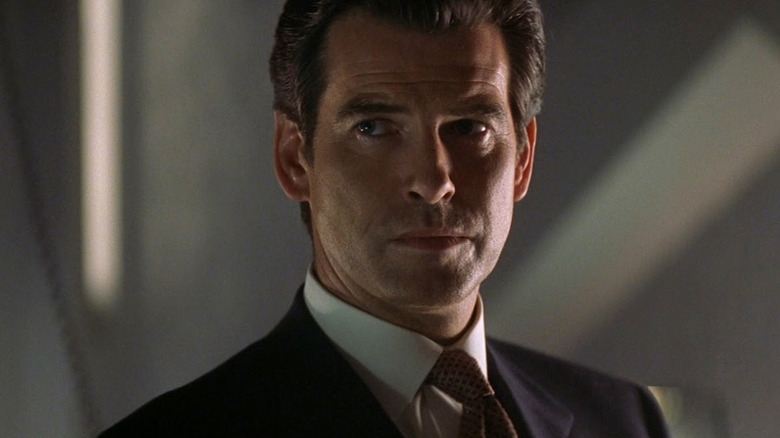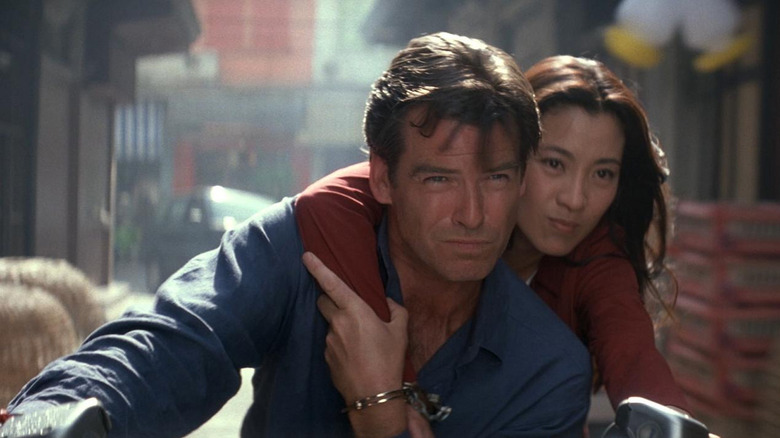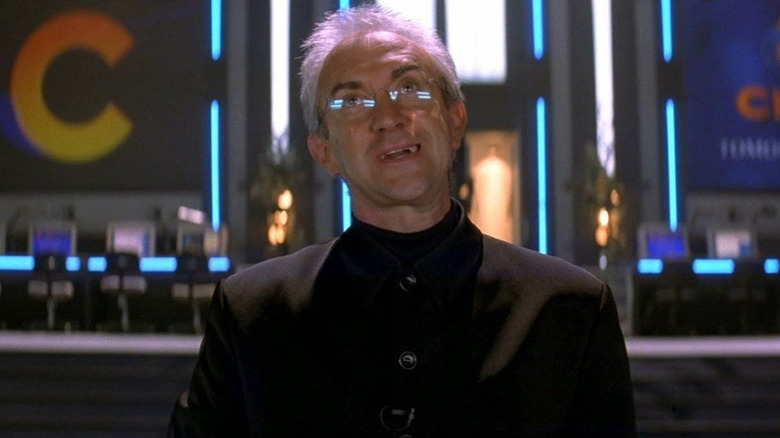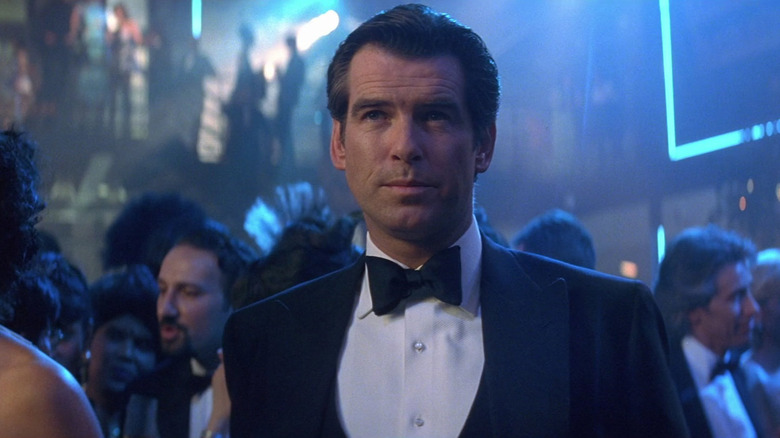Why Tomorrow Never Dies Had To Scrap Its Script Days Before Filming
After the huge success of "Goldeneye" the Bond franchise faced a dilemma — what next? Pierce Brosnan's first outing as 007 was a critical success and earned an impressive $352 million at the worldwide box office. More importantly, it gave a new generation its own Bond, with many fans, such as myself, desperate to see more of Brosnan's distinctly modern secret agent.
He followed it up with "Tomorrow Never Dies" starring Jonathan Pryce as media mogul Elliot Carver — a contemporary Bond villain for a new, media-obsessed world. Carver is the power-hungry boss of a media empire, hell-bent on extending the worrying reach of his news and television network by creating a conflict between the United Kingdom and China. It's quite the grand scheme, with more than a hint of Rupert Murdoch in Carver's characterization. But it looks as though it could have been even closer to real-life events.
The original "Tomorrow Never Dies" script went deep into the conflict between the United Kingdom and China, basing the entire thing around the upcoming real-life handover of Hong Kong from the UK to the Chinese government. It would have made "Tomorrow Never Dies" an even more contemporary Bond film than its predecessor, with a connection to current affairs that would make the nefarious media mogul's plans even more prescient.
But there's a good reason this never made it to the big screen.
There's no news like bad news
"Tomorrow Never Dies" was released just two years after "Goldeneye" — a hasty effort to capitalize on Pierce Brosnan's success as 007. The problem? When production began, "Tomorrow Never Dies" had nothing more than a release date. That's right — there was no script. No start date. Not even so much as an idea.
"Goldeneye" director Martin Campbell was naturally offered the chance to make a sequel, but with the production barely begun and an immovable start date just two years away, he understandably turned it down. Roger Spottiswoode, who took over from Campbell, faced a mammoth task – to get "Tomorrow Never Dies" over the finishing line.
But even getting it to the starting blocks would prove tricky. "Tomorrow Never Dies" was greenlit by MGM six whole months before "Goldeneye" debuted in theaters, giving the studio plenty of time to get its script sorted. At least, that's what they thought. An idea from "Goldeneye" co-writer Bruce Feirstein was chosen, and with its plot based on real-world events, it was the perfect follow-up to make James Bond's adventure even more realistic.
Here's Feirstein's original outline:
"Media tycoon, Elliot Harmsway, is enraged by Britain's cowardice in returning Hong Kong to China and intends to destroy the colony before the handover, while his media empire will benefit from worldwide coverage of the disaster."
Of course, there was a bit more to it than that. The "disaster" would have been the destruction of a nuclear reactor during the handover process, with Harmsway playing both sides to force them into all-out war. Throw in a traditional revenge motive and it's easy to see why MGM loved this idea. Tying "Tomorrow Never Dies" into current events would give the film a sense of urgency unmatched by any other Bond film that came before. There was just one problem — what happens if the handover goes sideways?
You provide the pictures, I'll provide the war
Before "Tomorrow Never Dies" could commence filming, the studio sent the script to its political advisor for approval — none other than former U.S. Secretary of State, Henry Kissinger. The idea was to nix any potentially insensitive stories before they got too far.
At least, according to MGM/UA executive vice president of production, Jeff Kleemen:
"You don't [want to] have a situation like we had on Goldeneye where we are a few days into shooting in London and the Militsiya comes out and we have to go back to London."
Unfortunately, it looks as though the "Tomorrow Never Dies" script was a bit on the nose. Kissinger ultimately advised against using it — his thinking was that basing the film on the upcoming handover of Hong Kong would instantly date the film. There was no way of knowing what would happen, and since the handover would occur several months before the film's release, it wasn't a good idea to wrap the film's plot around it. Most of all, there was no way to predict whether anything bad would happen during the handover.
"Nobody really knew whether it would be a peaceful handover," recalled Spottiswoode in the 2015 book, Some Kind of Hero: The Remarkable Story of James Bond Films. "To come up with a fantasied version of an event that was only a few months old, did not seem a very wise choice."
The decision was made to scrap the initial screenplay and go back to the drawing board ... but there was an even bigger problem. This left director Roger Spottiswoode without a script on the first day of filming.
Give the people what they want
"Tomorrow Never Dies" eventually resembled the original script in many ways, with Elliot Harmsway becoming the villain we know and love, Elliot Carver. But with time ticking away and a director waiting for a shooting script, the studio began to panic. And the film would go through a tonne of revisions first. After the initial script was canned, producer Jeff Kleemen assembled his very own writer's room, flying in scribes from across the globe to spend the week throwing around ideas. Robert Collector, David Campbell Wilson, Tom Ropelewski, Kurt Wimmer, Leslie Dixon, and Nicholas Meyer came up with a whole range of ideas from the sensible to the utterly insane. There was even one suggestion that Brosnan performed a scene in drag.
"We needed to throw everything we could at the script as fast as we could in order to generate the best possible version within the really meager time frame we had," said Kleemen.
Feirstein wrote an entirely new script before he was fired, with writers Nicolas Meyer and Daniel Petrie Jr. both penning their own additional versions of "Tomorrow Never Dies." But despite Petrie's version making it to the set, this too was nixed.
"It was not articulate or cohesive enough," said Brosnan. "I spoke to Barbara and Michael and said that it was inappropriate at this stage of filming we should be in such a fragile state. It was just a joke."
Running out of time and ideas, MGM hired Feirstein back ... and that's when the writer had a breakthrough. Harmsway was transformed into Carver – more of a Robert Maxwell type media mogul who was ultimately chasing ratings as a motive. The idea was based on CNN's historic rise to prominence during the Gulf War under the leadership of Wolf Blitzer. And the rest, as they say, is history.
Elliot Carver became a cut-throat news magnate with a lust for live coverage to bring in the ratings. Manufacturing his very own Gulf War-style conflict, he was the inventor of Fake News and became one of the most prescient Bond villains of our time.
"Elliot Carver foresaw Fake News — he manufactured Fake News," said Pryce. "He obviously gave Trump a lot of ideas about the industry. It certainly gave Murdoch a free rein to do whatever he wanted to do."
It's just a shame the film wasn't quite as good as "Goldeneye."



